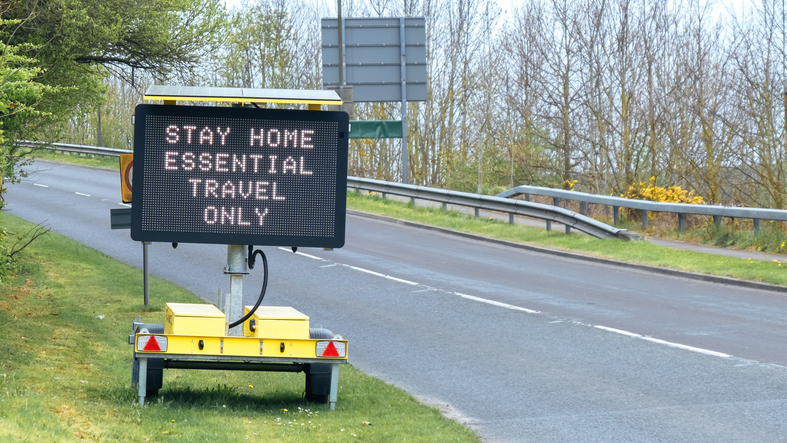Professor Iain Docherty, Dean of the Institute for Advanced Studies, University of Stirling
Dr Tom Forth, Head of Data, Open Data Institute Leeds
“In all affairs it’s a healthy thing now and then to hang a question mark on the things you have long taken for granted.”
― Bertrand Russell
We have become used to astounding numbers in the economic news due to the COVID-19 pandemic. A 35% fall in quarterly GDP, an increase in public sector net borrowing of 14% of GDP in a single year, the potential trebling of unemployment. But perhaps the most astonishing figure concerns the use of public transport. The number of people in the UK travelling by rail and tube is down by 97%. Declines in bus use are likely to be similar.
As government begins turning policy attention towards an ‘exit strategy’ from the current severe restrictions on economic and social life, transport will present one of the most difficult challenges. Whatever decisions are taken will have impacts everywhere, though particularly in our towns and cities.
Our response to the pandemic has shown how quickly society can make extreme changes when it needs to. It is a lesson worth learning. 5 years ago, a group of us were wrapping up a large project on transport disruption. Our headline finding was that by observing how people changed their behaviours in response to disruptions such as flooding or the sudden closure of a bridge, we could estimate the potential for radical change at other times. We hoped that governments would use this insight to make transport more resilient, more sustainable, and less carbon intensive even in the absence of disruption. Today we have more extreme disruption than we ever considered.
There have been some important quick wins for more sustainable transport during lockdown. Cities from Berlin to Bogotà have quickly reallocated road space, giving greater priority to pedestrians and cyclists. Reluctance to conduct virtual meetings has been overcome, leading to an exponential increase in the use of video conferencing software as organisations try to maintain their productivity despite the elimination of the majority of travel.
It is far from certain that longer term trends will be as positive. Business travel, and with it emissions, might bounce back as people tire of Zoom. The novelty of working from home will wear off for many who are missing the social contact of the workplace. The 97% fall in the use of public transport will not endure, but what part of it will?
Given the protracted and potentially stop-start exit from lockdown that faces us over the coming months, how many will feel safe using buses and trains again? Will sensible precautions such as requiring passengers to wear face masks scare people off public transport, or help them feel safe to return? Will journeys not taken by public transport be replaced by journeys by car or bicycle, on foot, or not taken at all? What will happen to demand for ride sharing services?
Such significant changes in the future of travel demand are important for two main reasons. First, because decarbonising transport at the rate required to meet the Paris Agreement on climate change necessitates not only adopting zero-emission vehicle technologies universally over the next decade or so, but also reducing the overall size of the vehicle fleet by around one third. A greater adoption of home working would help to achieve this goal. Any lasting shift away from public transport to increased car use would do the opposite, probably by much more.
Second, many of our assumptions about the productivity benefits of transport investments depend on people choosing to live, work, and socialise at high densities in city centres, enabled by mass transit. If fewer people choose to live in this way then the economic case for many large infrastructure investments will crumble. The use of appraisal techniques that claim to assume how society and the economy will work up to 60 years into the future will come under renewed scrutiny.
For all the difficulties that the transport sector will have in adapting to a post COVID-19 world, it has a significant advantage. We have been here before.
In the 1950s, the ‘dispersal’ of American cities into much more expansive, less dense forms was seen as a defence strategy against potential Soviet nuclear attack. Following 9/11, there was renewed debate in the US about whether a form of ‘anti-urbanism’ would take hold in which people were more hostile to the very idea of congregating in huge numbers in the largest cities.
The UK has avoided this level of drama in its debate about the future of cities and their role in socio-economic organisation. But we also have precedents to learn from. For example the July 2005 terror attacks in London prompted an instant decline in demand for tube travel of almost a third. This effect proved short lived with growth recovering to trend within months, although the important increase in cycling seen at the same time lasted.
We don’t know what the long-term effect of the COVID-19 pandemic on transport will be. It is possible that it will be a single discontinuity in longer term trends, similar to the disruption caused by terror attacks. But it could be a once-in-a-century rupture of those trends similar to the mass adoption of the motor car. Such a disruption would be so large that our assumptions about where, how and when we travel changes completely. The impact on the infrastructure we would need to build and maintain would be huge and only part of the wider implications for how we go about urban planning and economic development more generally.
This post first appeared on the Productivity Insights Network blog, where Dr Tom Forth led the project on Real City Size.

